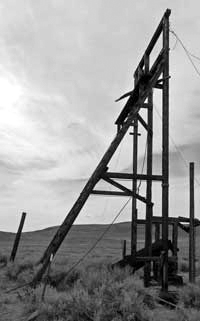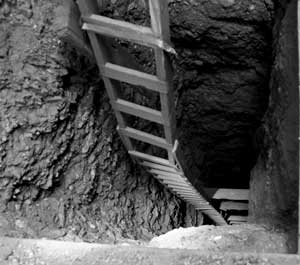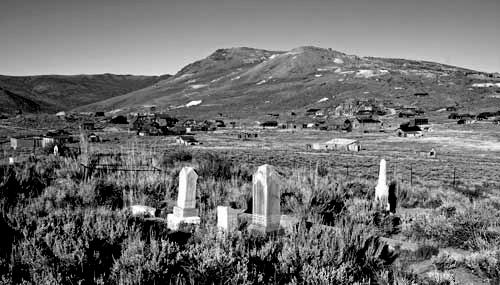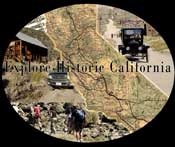|
The night watchman
stepped out into the bitter Bodie cold and began the last rounds of
his shift before heading to his cot in one of the dormitory style
rooms of the local hotels. A patch of red near the Ajax shaft, a
hundred feet east of the Champion Hoisting Works caught his eye
against the winter white backdrop. He plodded through the snow,
thankful that so far this year it had not quite been the kind that
brought Bodieites to crawl out of second floor windows and balconies
or dig tunnels to get out of the buildings.

The closer the
watchman got to the Ajax shaft, it became more and more obvious that
the red patch was a sack of some insignificant sort, and he began
wishing he had just ignored it and continued on his early daybreak
circuit. But he was almost there now, so he figured he could grab
the sack and dispose of it while he was, and it never hurt to take a
peak at the mouth of the vertical shaft itself to make sure it had
not been disturbed. He took several more steps, quivering as a
sudden blast of wind traveled down the bluff and worked against his
efforts to move forward. When at last he got to the mine opening, he
realized that there lying on the centerpiece across the hole, was a
standard gunny sack permanently dyed with red blood.
The afternoon of
the following day, the Ajax shaft at the Champion Mine was the scene
of quiet anticipation and speculation, as two men stood above
peering down it while waiting for the night watchman to come in from
town and join them. When he did, he produced lumber, nails, reel and
rope from the Champion Works and within ten minutes a worthy
windlass was constructed. One of the men, a reporter from the Bodie
Daily Free Press, prepared to descend. His companion, a workman
from the Bodie Mine, broke the silence between them, “Remember, now,
I saw two men toss a rather large wooden box down there two nights
ago.”

The reporter
nodded and secured his footing in the loop of the rope. As he
penetrated into the bowels of the mine, he noted the sturdiness of
the timber along the way, and was grateful for that. At the 120
foot level, he reached the snow and ice covered bottom. Immediately
his eyes set sight on a big wooden box, minus it’s lid, with one of
it’s ends frozen securely in the ice. Something appeared to be
wedged between the box and the ice it was stuck in. He was a bit
taken back when he realized it was a portion of a human arm and
elbow, with white firm flesh. Bodie, being a man for breakfast for
sort of town, the site was not totally unknown to the reporter, but
he could never had prepared himself for what he would uncover next.
Scattered about
the bottom of the Ajax shaft where the reporter stood, were several
pieces of bed sheet. In the opposite compartment of the shaft, he
found a rather large piece with something wrapped in it. As he
carefully unraveled it, his stomach roiled at the site of several
quantities of human flesh. Quickly he regained his composure and
studied the frozen solid flesh. He judged one piece of the flesh to
weigh in at about two pounds, then called up for a pick and axe for
further exploration.
Not far from the
wooden box, deeply buried in both ice and water, the reporter dug
out a badly bent and broken tobacco can. A glance inside revealed
the remains of a human hand, the size of a woman’s.
All manner of
horrific emotion welled within the reporter as he picked and prodded
carefully, and determined through the ice. One by one, in a
preserved state, he discovered an upper portion of a leg, then a
human trunk from neck to hips, both minus flesh and trunk minus
internal organs. He stared at his find, now in numbness. After short
pause and a perhaps a quick prayer, he took his grisly find to the
wooden box and carefully placed it inside. He took a couple of long
deep breathes, then gazed up the shaft and hollered for hoist.
Slowly and
cautiously the box was raised. As it reached the surface, the miner
and the night watchman could barely believe their eyes at the
abomination before them. The reporter was raised next, even more
sickened at the contents, as the sun brought it all to brighter
light.
It’s hard to
imagine in this modern day of all manner of instant communication,
how fast the news traveled throughout 1882 Bodie on this now bleak
February day. The entire town of Bodie, and the mining world on the
hill above, burst with the news of the woman’s body that was found
in the Champion Mine’s Ajax shaft. Coroner Deal was notified, of
course, and the box complete with gruesome contents, was taken to
him.
Hundreds of people
flocked to Brown’s Undertaking Room for a look at the remains. Many
weren’t satisfied with one look, but returned for a second and
perhaps a third…standing for long moments in a frozen state of
disbelief before the box, labeled "Reddington and Company," a
wholesale druggist in San Francisco.
Within two days
the Bodie Daily Free Press had put together the pieces
of the story:

Who
did the dirty work? How matters stand at present.
After a lapse of
three days, the mystery regarding the human remains found in an
abandoned shaft by the Free Press reporter is partially
explained, thanks to the work of an intelligent coroner's jury.
A great mass of testimony has been given and the outcome, so
far, is satisfactory in a measure. On December 8, 1881, Mary E.
Turner, a married woman, age 19 years, died and was buried in
the Bodie cemetery on the 9th. The finding of a human
remains and a general description of the same, led Mr. Turner to
the suspicion that they might be those of his wife. Wednesday
morning he and a few friends went to the cemetery and opened his
wife’s grave. Before reaching the proper depth, things did not
look right. When the coffin was reached, it was found to be
empty. The husband’s feelings can be better imagined than
described. The coroner’s jury after prolonged and tedious
examination of obstinate and unwilling witnesses traced the
remains found to Dr. Blackwood, who it appeared, dug them
himself or hired the disagreeable work done. He rented a vacant
house on Fuller Street for the purpose it is believed of
dissecting the body of the late Mrs. Turner whose skull found
its way to Dr. Jones’ office. A competent lady witness testified
that she recognized the same, as the skull of Mrs. Turner by the
teeth which were remarkably even and handsome. One witness
testified that he frequently accompanied Dr. Blackwood to the
dissecting room and saw him use a knife on the remains, cutting
away flesh and performing other work in that direction. The man
who so testified was one of the unwilling witnesses, but the
circumstances were such that he was forced to disgorge a portion
of his knowledge regarding the affair. Dr. Blackwood testified
that he knew nothing about the remains, and jumped the town and
has not been overtaken.

Bibliography:
Bodie Bonanza: The True Story of a Flamboyant Past
by Warren Loose
Chapter VIII, The Cruel
Years
Exposition Press/ New
York, 1971
Bodie Daily Free
Press (newspaper)
February 1882
|
